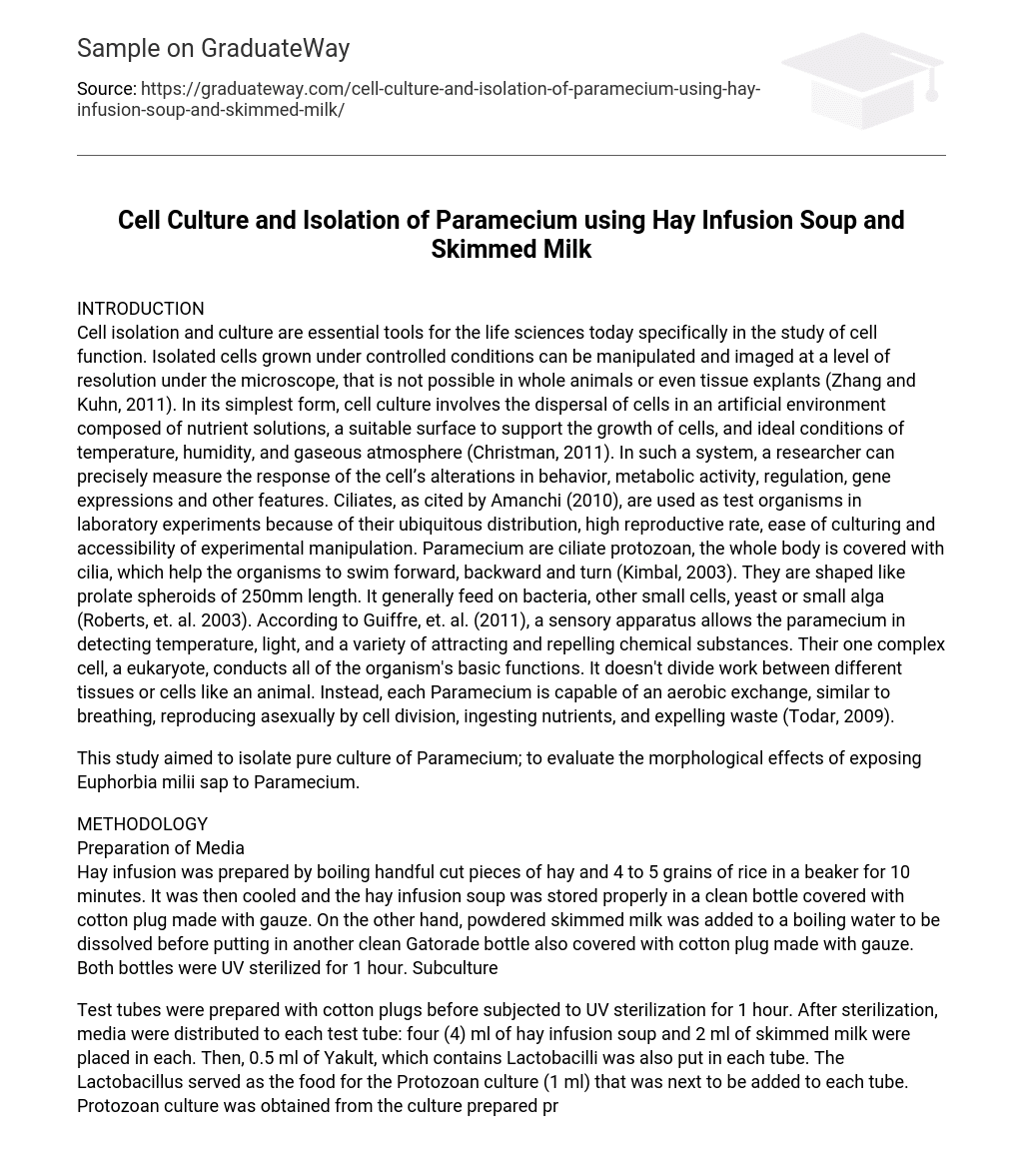INTRODUCTION
Cell isolation and culture are essential tools for the life sciences today specifically in the study of cell function. Isolated cells grown under controlled conditions can be manipulated and imaged at a level of resolution under the microscope, that is not possible in whole animals or even tissue explants (Zhang and Kuhn, 2011). In its simplest form, cell culture involves the dispersal of cells in an artificial environment composed of nutrient solutions, a suitable surface to support the growth of cells, and ideal conditions of temperature, humidity, and gaseous atmosphere (Christman, 2011). In such a system, a researcher can precisely measure the response of the cell’s alterations in behavior, metabolic activity, regulation, gene expressions and other features. Ciliates, as cited by Amanchi (2010), are used as test organisms in laboratory experiments because of their ubiquitous distribution, high reproductive rate, ease of culturing and accessibility of experimental manipulation. Paramecium are ciliate protozoan, the whole body is covered with cilia, which help the organisms to swim forward, backward and turn (Kimbal, 2003). They are shaped like prolate spheroids of 250mm length. It generally feed on bacteria, other small cells, yeast or small alga (Roberts, et. al. 2003). According to Guiffre, et. al. (2011), a sensory apparatus allows the paramecium in detecting temperature, light, and a variety of attracting and repelling chemical substances. Their one complex cell, a eukaryote, conducts all of the organism’s basic functions. It doesn’t divide work between different tissues or cells like an animal. Instead, each Paramecium is capable of an aerobic exchange, similar to breathing, reproducing asexually by cell division, ingesting nutrients, and expelling waste (Todar, 2009).
This study aimed to isolate pure culture of Paramecium; to evaluate the morphological effects of exposing Euphorbia milii sap to Paramecium.
METHODOLOGY
Preparation of Media
Hay infusion was prepared by boiling handful cut pieces of hay and 4 to 5 grains of rice in a beaker for 10 minutes. It was then cooled and the hay infusion soup was stored properly in a clean bottle covered with cotton plug made with gauze. On the other hand, powdered skimmed milk was added to a boiling water to be dissolved before putting in another clean Gatorade bottle also covered with cotton plug made with gauze. Both bottles were UV sterilized for 1 hour. Subculture
Test tubes were prepared with cotton plugs before subjected to UV sterilization for 1 hour. After sterilization, media were distributed to each test tube: four (4) ml of hay infusion soup and 2 ml of skimmed milk were placed in each. Then, 0.5 ml of Yakult, which contains Lactobacilli was also put in each tube. The Lactobacillus served as the food for the Protozoan culture (1 ml) that was next to be added to each tube. Protozoan culture was obtained from the culture prepared prior to the experiment. Checking
After overnight, samples from each test tube were obtained using a dropper which was then viewed under a microscope to check the culture.
RESULTS AND DISCUSSIONS
Paramecium is a small unicellular eukaryotic organism that is classified under the kingdom Protista and phylum Ciliophora. It lives in ponds or other sluggish freshwater habitats. As an organism that belongs to phylum Ciliophora, its body is surrounded by locomotor organs called cilia, hair-like structures which also aids in feeding (Campbell et al., 2008). This animal-like minute organism is the subject for isolation in this study (Figure 1).
With the use of hay infusion soup and skimmed milk as media and Lactobacillus as food, Protozoan cultures were able to thrive healthily. In fact, pure culture of Paramecium was seen. Amanchi (2010) stated that hay infusion was found to be the most appropriate culture medium for raring ciliates because it gives an environment nearest to their own habitat. Skimmed milk is used for microbiological culture media which supports the growth of many microorganisms like Lactobacilli (“Skim Milk”; “Skim Milk (7352)”, 2011). The Lactobacilli that were present in Yakult served as the food for the Paramecium in the culture. The Paramecium culture was originally subjected to exposure to toxicant of Euphorbia milii (Figure 2) sap to evaluate its morphological effects to the species but the culture became contaminated and molds were observed 3 days after checking (Figure 3). The unsuccessful experiment may be due the performers’ lack of proper observation of aseptic technique which is really needed in doing such laboratory experiments; protocol was not properly followed; poor condition of the working place as well as the unsterile materials used.
CONCLUSION
Paramecium sp. successfully thrived in the culture media made of hay infusion soup and skim milk as well as Lactobacilli. But in order to keep the culture healthy and to avoid contaminations, proper handling and correct protocol should be done. Moreover, aseptic techniques should always be observed. REFERENCES
Literatures cited
1. Amanchi, Nageswara. 2010. A low cost microbiotest for screening behavioural and ecotoxicological responses of Paramecium caudatum and Oxytricha fallax to azadirachtin. Advances in Applied Science Reseacrh 1: 124-131. 2. Campbell, N.A., et. al. 2008.
Biology. 8th Edition. Singapore: Pearson Education South Asia Pte Ltd. 3. Christman, M. 2011. What is cell
culture? Coriell Institute for Medical Research. Retrieved from < http://www.coriell.org/research-services/cell-culture/what-is-cell-culture > 1 April 2013. 4. Giuffre, C., et. al. 2011. Ciliated
Paramecium Shows Higher Motility in Non-Uniform Chemical Landscapes. 5. Kimball, J.W. 2003. The Ciliate
Protozoans
6. Kuhn, J. and Zhang, S. 2011. Cell
Isolation and Culture. Retrieved from < http://www.plosone.org/article/info:doi/10.1371/journal.pone.0019505> 1 April 2013. 7. Roberts, C.E, et. al. 1995.
Microbiology: A Human Perspective. C. Brown Publishers, Dubuque. 8. Todar, K. 2009. Introduction to the
Cell Microbial World.
Online references
1. Skim Milk. [Online] Available at:
http://www.bd.com/europe/regulatory/Assets/IFU/Difco_BBL/232100.pdf [Accessed: 2 April 2013] 2. Skim Milk (7352). [Online]
Available at: http://www.neogen.com/Acumedia/pdf/ProdInfo/7352_PI.pdf [Accessed: 2 April 2013]





